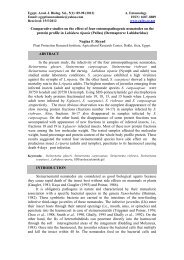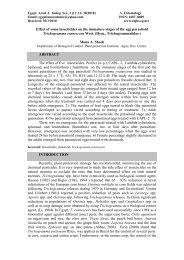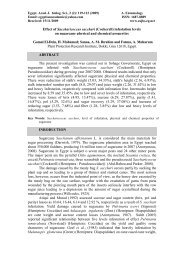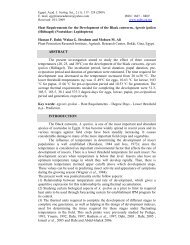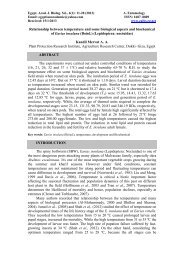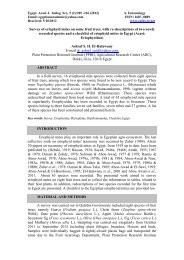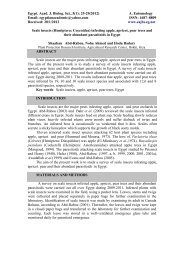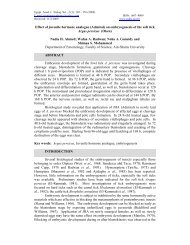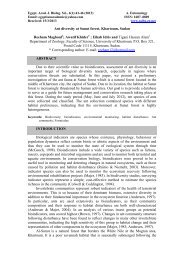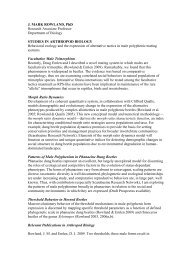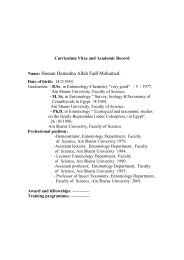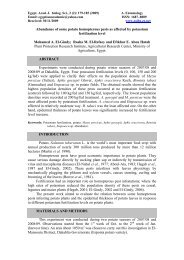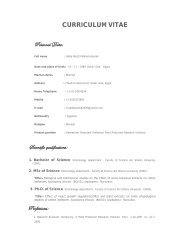Combined effect of ozone mixed with carbon dioxide on the mortality ...
Combined effect of ozone mixed with carbon dioxide on the mortality ...
Combined effect of ozone mixed with carbon dioxide on the mortality ...
Create successful ePaper yourself
Turn your PDF publications into a flip-book with our unique Google optimized e-Paper software.
Egypt. Acad. J. biolog. Sci., 4 (2):9 – 19(2011) A. Entomology<br />
Email: egyptianacademic@yahoo.com ISSN: 1687–8809<br />
Received: 11/12/2011 www.eajbs.eg.net<br />
<str<strong>on</strong>g>Combined</str<strong>on</strong>g> <str<strong>on</strong>g>effect</str<strong>on</strong>g> <str<strong>on</strong>g>of</str<strong>on</strong>g> <str<strong>on</strong>g>oz<strong>on</strong>e</str<strong>on</strong>g> <str<strong>on</strong>g>mixed</str<strong>on</strong>g> <str<strong>on</strong>g>with</str<strong>on</strong>g> <str<strong>on</strong>g>carb<strong>on</strong></str<strong>on</strong>g> <str<strong>on</strong>g>dioxide</str<strong>on</strong>g> <strong>on</strong> <strong>the</strong> <strong>mortality</strong> <str<strong>on</strong>g>of</str<strong>on</strong>g> five<br />
stored-product insects<br />
Golam Reza Sadeghi; Ali Asgar Pourmirza and Mohammad Hasan Safaralizade<br />
Department <str<strong>on</strong>g>of</str<strong>on</strong>g> Plant Protecti<strong>on</strong>, Agricultural Faculty, Urmia University, Urmia- IRAN.<br />
Email: rsadeghi1357@yahoo.com<br />
ABSTRACT<br />
A study to determine <strong>the</strong> <str<strong>on</strong>g>effect</str<strong>on</strong>g> <str<strong>on</strong>g>of</str<strong>on</strong>g> <str<strong>on</strong>g>oz<strong>on</strong>e</str<strong>on</strong>g> <str<strong>on</strong>g>mixed</str<strong>on</strong>g> <str<strong>on</strong>g>with</str<strong>on</strong>g> <str<strong>on</strong>g>carb<strong>on</strong></str<strong>on</strong>g> <str<strong>on</strong>g>dioxide</str<strong>on</strong>g> <strong>on</strong> c<strong>on</strong>trolling<br />
stored-grain insects was c<strong>on</strong>ducted in <strong>the</strong> storehouse. Adults <str<strong>on</strong>g>of</str<strong>on</strong>g> Sitophilus oryzae (L.),<br />
Tribolium castaneum (Herbst), Rhyzopertha dominica(F.), Oryzephilus<br />
surinamensis(L.) and 3 th larvae <str<strong>on</strong>g>of</str<strong>on</strong>g> Plodia interpunctella(Hubner) were exposed to <strong>the</strong><br />
mixture <str<strong>on</strong>g>of</str<strong>on</strong>g> <str<strong>on</strong>g>oz<strong>on</strong>e</str<strong>on</strong>g> and <str<strong>on</strong>g>carb<strong>on</strong></str<strong>on</strong>g> <str<strong>on</strong>g>dioxide</str<strong>on</strong>g>. After exposure periods <str<strong>on</strong>g>of</str<strong>on</strong>g> 24 h, <strong>the</strong> insects were<br />
transferred to clean jars c<strong>on</strong>taining food and held at 27±2 º C and 65 ±5% R.H.<br />
Experiments were performed in different heights (30, 40, 50 and 100 cm) and<br />
nutriti<strong>on</strong> materials (date, wheat and rice), in penetrati<strong>on</strong> tests and empty-space tests.<br />
In empty-space trials, <strong>the</strong> highest <strong>mortality</strong> was for P. interpunctella. In penetrati<strong>on</strong><br />
tests, treatment <str<strong>on</strong>g>with</str<strong>on</strong>g> high-pressure <str<strong>on</strong>g>oz<strong>on</strong>e</str<strong>on</strong>g> and <str<strong>on</strong>g>carb<strong>on</strong></str<strong>on</strong>g> <str<strong>on</strong>g>dioxide</str<strong>on</strong>g> under different height<br />
and foodstuff may result in different rates <str<strong>on</strong>g>of</str<strong>on</strong>g> <strong>mortality</strong>. The mixture <str<strong>on</strong>g>of</str<strong>on</strong>g> <str<strong>on</strong>g>oz<strong>on</strong>e</str<strong>on</strong>g> and<br />
<str<strong>on</strong>g>carb<strong>on</strong></str<strong>on</strong>g> <str<strong>on</strong>g>dioxide</str<strong>on</strong>g> in <strong>the</strong> interacti<strong>on</strong> between height and diet (heigh×diet) are not<br />
significant for <strong>the</strong> S. oryzae, T. castaneum, R. dominicaand P. interpunctellabut for O.<br />
surinamensis is significant. The influence <str<strong>on</strong>g>of</str<strong>on</strong>g> <str<strong>on</strong>g>oz<strong>on</strong>e</str<strong>on</strong>g> gas and <str<strong>on</strong>g>carb<strong>on</strong></str<strong>on</strong>g> <str<strong>on</strong>g>dioxide</str<strong>on</strong>g> in <strong>the</strong> date<br />
is more than rice and wheat. The mixture <str<strong>on</strong>g>of</str<strong>on</strong>g> <str<strong>on</strong>g>oz<strong>on</strong>e</str<strong>on</strong>g> <str<strong>on</strong>g>with</str<strong>on</strong>g> <str<strong>on</strong>g>carb<strong>on</strong></str<strong>on</strong>g> <str<strong>on</strong>g>dioxide</str<strong>on</strong>g> can be as<br />
suitable fumigant for decreasing phosphine and methyl bromide under ambient<br />
storage c<strong>on</strong>diti<strong>on</strong>s in penetrati<strong>on</strong> and empty-space fumigati<strong>on</strong>s.<br />
Keywords: Fumigant, foodstuff, phosphine, methyl bromide.<br />
INTRODUCTION<br />
Stored products <str<strong>on</strong>g>of</str<strong>on</strong>g> agricultural are attacked by more than 1200 species <str<strong>on</strong>g>of</str<strong>on</strong>g> pests<br />
(Rajendran, 2002). In recent years <strong>the</strong> number <str<strong>on</strong>g>of</str<strong>on</strong>g> fumigants available for use against<br />
stored-product insects has been decreased because <str<strong>on</strong>g>of</str<strong>on</strong>g> <strong>the</strong> removal <str<strong>on</strong>g>of</str<strong>on</strong>g> fumigants such<br />
as <str<strong>on</strong>g>carb<strong>on</strong></str<strong>on</strong>g> disulphide and ethylene dibromide and <strong>on</strong>ly two fumigants, methyl bromide<br />
and phosphine are in use (Leesch, 1995). Methyl bromide depletes <strong>the</strong> <str<strong>on</strong>g>oz<strong>on</strong>e</str<strong>on</strong>g> layer<br />
(Cassanova, 2002), thus applicati<strong>on</strong> <str<strong>on</strong>g>of</str<strong>on</strong>g> it will be abolished in <strong>the</strong> developed countries<br />
in immediate feature (UNEP, 1998). Phosphine is an appropriate fumigant but<br />
because <str<strong>on</strong>g>of</str<strong>on</strong>g> slowness in its functi<strong>on</strong>, insects resistance to it has been developed in<br />
various countries (Zettler, 1993). Mills shows <strong>the</strong> c<strong>on</strong>stant use <str<strong>on</strong>g>of</str<strong>on</strong>g> phosphine as <strong>the</strong><br />
main result for <strong>the</strong> increase in <strong>the</strong> insects' resistance to this fumigant (Mills, 2001;<br />
Mills and Pacho, 1996). Resistance to phosphine has been observed in S. oryzae, T.<br />
castaneum and R. dominica (Chimbe and Galley, 1996; Collins et al., 2002). Due to<br />
<strong>the</strong> M<strong>on</strong>treal Protocol, pesticide resistance and <strong>the</strong> increased demand for organic<br />
grains, food manufacturers and grain handlers around <strong>the</strong> world are looking for novel<br />
ways to c<strong>on</strong>trol insects and pathogens in stored commodities (Zettler et al., 1989;<br />
Zettler and Cuperus, 1990).Exposure <str<strong>on</strong>g>of</str<strong>on</strong>g> insects to toxic c<strong>on</strong>centrati<strong>on</strong>s <str<strong>on</strong>g>of</str<strong>on</strong>g> atmospheric<br />
gases has been practiced for centuries and has been promoted in recent years as a<br />
biorati<strong>on</strong>al substitute for chemical fumigati<strong>on</strong>s (Navarro, 2006). The cost <str<strong>on</strong>g>of</str<strong>on</strong>g> gases<br />
needed for c<strong>on</strong>trolled atmospheres may also be a hindrance to adopti<strong>on</strong>. Carb<strong>on</strong>
10<br />
Golam Reza Sadeghi et al.<br />
<str<strong>on</strong>g>dioxide</str<strong>on</strong>g> has been used as a viable alternative to phosphine for <strong>the</strong> c<strong>on</strong>trol <str<strong>on</strong>g>of</str<strong>on</strong>g> insects<br />
attacking stored products (Jay, 1986). CO2 is efficient <strong>on</strong>ly when c<strong>on</strong>centrati<strong>on</strong>s<br />
higher than 40% are maintained for l<strong>on</strong>g periods. Exposure periods l<strong>on</strong>ger than 14 d<br />
are required to kill <strong>the</strong> insects when <strong>the</strong> c<strong>on</strong>centrati<strong>on</strong> <str<strong>on</strong>g>of</str<strong>on</strong>g> CO2 in <strong>the</strong> air is below 40%<br />
(Kashi, 1981). Oz<strong>on</strong>e is a triatomic form <str<strong>on</strong>g>of</str<strong>on</strong>g> oxygen (O3) and is referred to as activated<br />
oxygen, or allotropicoxygen. Oz<strong>on</strong>e can be generated by electrical charges in air and<br />
is currently used in <strong>the</strong> medical industry as a disinfecti<strong>on</strong> technique against<br />
microorganisms and viruses, as a means <str<strong>on</strong>g>of</str<strong>on</strong>g> reducing odor, and for removing taste,<br />
colour, and envir<strong>on</strong>mental pollutants in industrial applicati<strong>on</strong>s (Kim et al., 1999). In<br />
1997, <str<strong>on</strong>g>oz<strong>on</strong>e</str<strong>on</strong>g> was recognized as being generally safe (GRAS) for food c<strong>on</strong>tact<br />
applicati<strong>on</strong>s in <strong>the</strong> United States (Graham et al., 1997; U.S. Food and Drug<br />
Administrati<strong>on</strong>, 1997). Since that time, interest in developing <str<strong>on</strong>g>oz<strong>on</strong>e</str<strong>on</strong>g> applicati<strong>on</strong>s in<br />
<strong>the</strong> food industry has increased, although some regulatory issues regarding <str<strong>on</strong>g>oz<strong>on</strong>e</str<strong>on</strong>g> use<br />
for this purpose have not been resolved. Electrical generati<strong>on</strong> <str<strong>on</strong>g>of</str<strong>on</strong>g> <str<strong>on</strong>g>oz<strong>on</strong>e</str<strong>on</strong>g> eliminates <strong>the</strong><br />
handling, storage, and disposal problems <str<strong>on</strong>g>of</str<strong>on</strong>g> c<strong>on</strong>venti<strong>on</strong>ally used post-harvest<br />
pesticides. An attractive aspect <str<strong>on</strong>g>of</str<strong>on</strong>g> <str<strong>on</strong>g>oz<strong>on</strong>e</str<strong>on</strong>g> is that it decomposes rapidly (<str<strong>on</strong>g>with</str<strong>on</strong>g>in about<br />
50 min) to molecular oxygen <str<strong>on</strong>g>with</str<strong>on</strong>g>out leaving a residue. These attributes make <str<strong>on</strong>g>oz<strong>on</strong>e</str<strong>on</strong>g><br />
an attractive candidate for c<strong>on</strong>trolling insects and fungi in stored products. At low<br />
c<strong>on</strong>centrati<strong>on</strong>s <str<strong>on</strong>g>oz<strong>on</strong>e</str<strong>on</strong>g> protects clean surfaces from subsequent fungal c<strong>on</strong>taminati<strong>on</strong><br />
and growth, although higher doses are required to kill fungi <strong>on</strong> c<strong>on</strong>taminated surfaces<br />
(Rice et al., 1982). Five ppm <str<strong>on</strong>g>oz<strong>on</strong>e</str<strong>on</strong>g> inhibited surface growth, sporulati<strong>on</strong>, and<br />
mycotoxin producti<strong>on</strong> by cultures <str<strong>on</strong>g>of</str<strong>on</strong>g> Aspergillus flavus Link and Fusarium<br />
m<strong>on</strong>iliforme Sheld<strong>on</strong> (Mas<strong>on</strong> et al., 1997). Oz<strong>on</strong>e in its gaseous form has also been<br />
shown to have potential to kill insect pests in commodities (Erdman, 1980; Mas<strong>on</strong> et<br />
al., 1997; Kells et al., 2001). High <strong>mortality</strong> was achieved for adults <str<strong>on</strong>g>of</str<strong>on</strong>g> <strong>the</strong> maize<br />
weevil, Sitophilus zeamais Motschulsky, and <strong>the</strong> c<strong>on</strong>fused flour beetle Tribolium<br />
c<strong>on</strong>fusum du Val, and <strong>the</strong> larval stage <str<strong>on</strong>g>of</str<strong>on</strong>g> <strong>the</strong> Indian meal moth, Plodia interpunctella<br />
(Hubner) exposed to low <str<strong>on</strong>g>oz<strong>on</strong>e</str<strong>on</strong>g> c<strong>on</strong>centrati<strong>on</strong>s ranging from 5 to 45 ppm (Erdman,<br />
1980; Kells et al., 2001). Erdman (1980) also observed <strong>mortality</strong> <str<strong>on</strong>g>of</str<strong>on</strong>g> larvae <str<strong>on</strong>g>of</str<strong>on</strong>g> T.<br />
c<strong>on</strong>fusum and <strong>the</strong> red flour beetle, Tribolium castaneum (Herbst) when exposed to a<br />
45 ppm <str<strong>on</strong>g>oz<strong>on</strong>e</str<strong>on</strong>g> envir<strong>on</strong>ment. Leesch (2003) tested <str<strong>on</strong>g>oz<strong>on</strong>e</str<strong>on</strong>g> as a toxicant to storedproduct<br />
insects in <strong>the</strong> hope <str<strong>on</strong>g>of</str<strong>on</strong>g> killing insects at low dosages in short periods <str<strong>on</strong>g>of</str<strong>on</strong>g> time.<br />
In his study, even high c<strong>on</strong>centrati<strong>on</strong>s <str<strong>on</strong>g>of</str<strong>on</strong>g> 200–500 ppm (v/v) required many hours to<br />
kill <strong>the</strong> insects exposed. O<strong>the</strong>r than <strong>the</strong>se studies, little has been d<strong>on</strong>e to determine<br />
susceptibility <str<strong>on</strong>g>of</str<strong>on</strong>g> stored-product insects to <str<strong>on</strong>g>oz<strong>on</strong>e</str<strong>on</strong>g> treatments. The purpose <str<strong>on</strong>g>of</str<strong>on</strong>g> this study<br />
was to determine <strong>the</strong> <str<strong>on</strong>g>effect</str<strong>on</strong>g> <str<strong>on</strong>g>of</str<strong>on</strong>g> O3 <str<strong>on</strong>g>mixed</str<strong>on</strong>g> <str<strong>on</strong>g>with</str<strong>on</strong>g> CO2 <strong>on</strong> <strong>the</strong> <strong>mortality</strong> <str<strong>on</strong>g>of</str<strong>on</strong>g> stored-products<br />
insects for reduce <strong>the</strong> appropriate amount <str<strong>on</strong>g>of</str<strong>on</strong>g> gaseous <str<strong>on</strong>g>oz<strong>on</strong>e</str<strong>on</strong>g>.<br />
MATERIALS AND METHODS<br />
This study was carried out in two stages at <strong>the</strong> fumigati<strong>on</strong> store <str<strong>on</strong>g>of</str<strong>on</strong>g> entomology,<br />
Urmia University during <strong>the</strong> period <str<strong>on</strong>g>of</str<strong>on</strong>g> 2009-2010. In <strong>the</strong> first stage, <str<strong>on</strong>g>oz<strong>on</strong>e</str<strong>on</strong>g> and <str<strong>on</strong>g>carb<strong>on</strong></str<strong>on</strong>g><br />
<str<strong>on</strong>g>dioxide</str<strong>on</strong>g> were tested against insects in an empty- space. In <strong>the</strong> sec<strong>on</strong>d stage, <strong>the</strong> <str<strong>on</strong>g>effect</str<strong>on</strong>g><br />
<str<strong>on</strong>g>of</str<strong>on</strong>g> <str<strong>on</strong>g>oz<strong>on</strong>e</str<strong>on</strong>g> and <str<strong>on</strong>g>carb<strong>on</strong></str<strong>on</strong>g> <str<strong>on</strong>g>dioxide</str<strong>on</strong>g> were determined by c<strong>on</strong>fining <strong>the</strong> insects under different<br />
heights and nutriti<strong>on</strong> materials.<br />
Oz<strong>on</strong>e<br />
Gaseous <str<strong>on</strong>g>oz<strong>on</strong>e</str<strong>on</strong>g> was generated using a laboratory cor<strong>on</strong>a discharge <str<strong>on</strong>g>oz<strong>on</strong>e</str<strong>on</strong>g><br />
generator (Model OZO-1VTT provided by <strong>the</strong> company Ozomax Inc.<br />
(http://www.ozomax.com), Canada) <str<strong>on</strong>g>with</str<strong>on</strong>g> 5 g / h <str<strong>on</strong>g>of</str<strong>on</strong>g> output from purified extra dry
<str<strong>on</strong>g>Combined</str<strong>on</strong>g> <str<strong>on</strong>g>effect</str<strong>on</strong>g> <str<strong>on</strong>g>of</str<strong>on</strong>g> <str<strong>on</strong>g>oz<strong>on</strong>e</str<strong>on</strong>g> <str<strong>on</strong>g>mixed</str<strong>on</strong>g> <str<strong>on</strong>g>with</str<strong>on</strong>g> <str<strong>on</strong>g>carb<strong>on</strong></str<strong>on</strong>g> <str<strong>on</strong>g>dioxide</str<strong>on</strong>g> <strong>on</strong> <strong>the</strong> <strong>mortality</strong> <str<strong>on</strong>g>of</str<strong>on</strong>g> five stored-product insects 11<br />
oxygen (O2) feed gas. The generator is capable <str<strong>on</strong>g>of</str<strong>on</strong>g> producing 13.88 mg/L <str<strong>on</strong>g>oz<strong>on</strong>e</str<strong>on</strong>g> at an<br />
O2 flow rate <str<strong>on</strong>g>of</str<strong>on</strong>g> 6 L/min at room temperature.<br />
Carb<strong>on</strong> <str<strong>on</strong>g>dioxide</str<strong>on</strong>g><br />
The CO2 atmospheres were obtained by replacement <str<strong>on</strong>g>of</str<strong>on</strong>g> a volume <str<strong>on</strong>g>of</str<strong>on</strong>g> atmospheric<br />
air taken from <strong>the</strong> desiccators <str<strong>on</strong>g>with</str<strong>on</strong>g> <strong>the</strong> same volume <str<strong>on</strong>g>of</str<strong>on</strong>g> CO2 to obtain c<strong>on</strong>centrati<strong>on</strong> <str<strong>on</strong>g>of</str<strong>on</strong>g><br />
30%.<br />
Each desiccator was fitted <str<strong>on</strong>g>with</str<strong>on</strong>g> <strong>on</strong>e valve which permitted <strong>the</strong> <str<strong>on</strong>g>with</str<strong>on</strong>g>drawal or<br />
introducti<strong>on</strong> <str<strong>on</strong>g>of</str<strong>on</strong>g> gas.<br />
Fumigati<strong>on</strong> chamber<br />
The fumigati<strong>on</strong> chamber had <strong>the</strong> following internal dimensi<strong>on</strong>s: 4.7 m l<strong>on</strong>g, 2.8<br />
m wide and 2.9 m high (volume about 38 m 3 ) c<strong>on</strong>taining bins <str<strong>on</strong>g>with</str<strong>on</strong>g> different height<br />
(30, 40, 50 and 100 cm) and 20 cm in diameter were placed in middle <str<strong>on</strong>g>of</str<strong>on</strong>g> fumigati<strong>on</strong><br />
chamber, <str<strong>on</strong>g>of</str<strong>on</strong>g> date, wheat and rice were used for filling <strong>the</strong> bins.<br />
Test insects<br />
Sitophilus oryzae (Coleoptera: Curculi<strong>on</strong>idae), Triobolium castaneum<br />
(Coleoptera: Tenebri<strong>on</strong>idae), Rhyzopertha dominica (Coleoptera: Bostrychidae),<br />
Oryzephilus surinamensis(Coleoptera: Silvanidae) and 3 th larvae <str<strong>on</strong>g>of</str<strong>on</strong>g> Plodia<br />
interpunctella (Lepidoptera: Pyralidae), adults were collected from local mills, stores<br />
and shops in Urmia (37.39ºN 45.40ºE), a town in Iran. Cultures were established and<br />
maintained <strong>on</strong> healthy unc<strong>on</strong>taminated food at 27±2ºC and 65±5% R.H. in glass<br />
bottles 1.5 L covered <str<strong>on</strong>g>with</str<strong>on</strong>g> pieces <str<strong>on</strong>g>of</str<strong>on</strong>g> muslin cloth fixed by rubber bands. All insects<br />
were cultured under moderately crowded c<strong>on</strong>diti<strong>on</strong>s to ensure proper development<br />
and equal size <str<strong>on</strong>g>of</str<strong>on</strong>g> <strong>the</strong> resultant adults. S. oryzae and R. dominica were reared <strong>on</strong> S<str<strong>on</strong>g>of</str<strong>on</strong>g>t<br />
kernel wheat (Padin et al., 2002; Bell et al., 1977), <strong>the</strong> culture medium comprised<br />
whole-wheat flour <str<strong>on</strong>g>with</str<strong>on</strong>g> 5% yeast for T. castaneum (Childs and Overby, 1983), O.<br />
surinamensis was reared <strong>on</strong> oat (Tunҫbilek, 1997) and P. interpunctella was reared <strong>on</strong><br />
diet <str<strong>on</strong>g>of</str<strong>on</strong>g> 80% ground wheat 10%glycerin, 5% brewerۥs yeast and 5% h<strong>on</strong>ey (Rafaeli and<br />
Gileadi, 1995).<br />
Bioassays<br />
The following developmental stages <str<strong>on</strong>g>of</str<strong>on</strong>g> insects were used in <strong>the</strong>se tests: (i) S.<br />
oryzae and R. dominica adults 7±2 day old, (ii) T. castaneum adults, 14±3 day old,<br />
(iii) O. surinamensisadults 3 day old and (iiii) 3 th larvae <str<strong>on</strong>g>of</str<strong>on</strong>g> P. interpunctella.<br />
Preliminary dose-<strong>mortality</strong> tests were d<strong>on</strong>e before each experiment to determine a<br />
range <str<strong>on</strong>g>of</str<strong>on</strong>g> doses that would produce 25-75% <strong>mortality</strong> at <strong>the</strong> lowest and <strong>the</strong> highest<br />
doses, respectively (Roberts<strong>on</strong> and Preisler, 1992). In each experiment insects were<br />
allowed to recover <strong>on</strong> <strong>the</strong>ir usual media at 27±2ºC and 60±5% R.H. In each bioassay<br />
<strong>mortality</strong> was recorded after exposure and recovery period. Those insects that did not<br />
move when lightly probed or shaken in <strong>the</strong> light and mild heat were c<strong>on</strong>sidered dead.<br />
Empty-space and penetrati<strong>on</strong> tests were c<strong>on</strong>ducted in 38 m 3 capacity chamber.<br />
Empty-space tests<br />
Adults (<str<strong>on</strong>g>mixed</str<strong>on</strong>g>-sex) <str<strong>on</strong>g>of</str<strong>on</strong>g> S. oryzae,T. castaneum, R. dominica, O. surinamensis and<br />
3 th larvae <str<strong>on</strong>g>of</str<strong>on</strong>g> P. interpunctella were fumigated for 24 h in <strong>the</strong> fumigati<strong>on</strong> chamber,<br />
separately. The test insects were c<strong>on</strong>fined in cages c<strong>on</strong>structed <str<strong>on</strong>g>with</str<strong>on</strong>g> 40 mesh wire<br />
gauze. Each cage c<strong>on</strong>tained 20 insects and 3 g food, <strong>the</strong>n door <str<strong>on</strong>g>of</str<strong>on</strong>g> chamber were<br />
entirely closed and 90mg/l <str<strong>on</strong>g>of</str<strong>on</strong>g> gaseous <str<strong>on</strong>g>oz<strong>on</strong>e</str<strong>on</strong>g> was injected <str<strong>on</strong>g>with</str<strong>on</strong>g> a hose which was<br />
made relati<strong>on</strong> between injecti<strong>on</strong> gate <str<strong>on</strong>g>of</str<strong>on</strong>g> <str<strong>on</strong>g>oz<strong>on</strong>e</str<strong>on</strong>g> generator and <strong>the</strong>n 30% <str<strong>on</strong>g>of</str<strong>on</strong>g> camberۥs<br />
value was filled <str<strong>on</strong>g>with</str<strong>on</strong>g> <str<strong>on</strong>g>carb<strong>on</strong></str<strong>on</strong>g> <str<strong>on</strong>g>dioxide</str<strong>on</strong>g> which was introduced into <strong>the</strong> fumigati<strong>on</strong><br />
chamber from CO2 cylinders which <strong>the</strong>ir weight was 5 Kg. Immediately after <strong>the</strong> O3<br />
and CO2 injecti<strong>on</strong> <strong>the</strong> injecti<strong>on</strong> gate was closed. In each test, <strong>the</strong> c<strong>on</strong>trol insects were<br />
treated identically except that no expose to O3 and CO2. After exposure periods <str<strong>on</strong>g>of</str<strong>on</strong>g> 24 h,
12<br />
Golam Reza Sadeghi et al.<br />
<strong>the</strong> insects were transferred to clean jars c<strong>on</strong>taining food and held at 27±2 º C and<br />
65 ±5% r. h. Mortality rates <str<strong>on</strong>g>of</str<strong>on</strong>g>, S. oryzae, T. castaneum, R. dominica, O. surinamensis<br />
adult and 3 th larvae <str<strong>on</strong>g>of</str<strong>on</strong>g> P. interpunctella were recorded 24h after terminati<strong>on</strong><br />
exposure.(Pourmirza and Tajbakhsh, 2008).<br />
Penetrati<strong>on</strong> tests<br />
The penetrati<strong>on</strong> tests were carried out in <strong>the</strong> above menti<strong>on</strong>ed chamber (38 m 3 ).<br />
Experiments were performed in different heights (30, 40, 50 and 100 cm) and<br />
nutriti<strong>on</strong> materials (date, wheat and rice). For each experiment five cages for five<br />
experimented species (Adults (<str<strong>on</strong>g>mixed</str<strong>on</strong>g>-sex) <str<strong>on</strong>g>of</str<strong>on</strong>g> S. oryzae, T. castaneum, R. dominica, O.<br />
surinamensis and 3 th larvae <str<strong>on</strong>g>of</str<strong>on</strong>g> P. interpunctella, each c<strong>on</strong>taining 20 adults <str<strong>on</strong>g>of</str<strong>on</strong>g> <strong>on</strong>e<br />
insect species <str<strong>on</strong>g>with</str<strong>on</strong>g> 3 g food) were placed horiz<strong>on</strong>tally at <strong>the</strong> bottom <str<strong>on</strong>g>of</str<strong>on</strong>g> PVC bins <str<strong>on</strong>g>with</str<strong>on</strong>g><br />
different heights. Each bin was filled by 3 menti<strong>on</strong>ed different nutriti<strong>on</strong> materials<br />
separately. The procedure used was similar to those described for <strong>the</strong> empty- space<br />
tests (in penetrati<strong>on</strong> tests used <str<strong>on</strong>g>of</str<strong>on</strong>g> 120mg/l O3 for injecti<strong>on</strong> <str<strong>on</strong>g>with</str<strong>on</strong>g> 30% Co2). Each<br />
experiment was replicated three times in three days. The c<strong>on</strong>trol case was prepared in<br />
identical manner <str<strong>on</strong>g>with</str<strong>on</strong>g>out applicati<strong>on</strong> test compounds. After exposure periods <str<strong>on</strong>g>of</str<strong>on</strong>g> 24 h,<br />
<strong>the</strong> insects were transferred to clean jars c<strong>on</strong>taining food and held at 27±2 º C and<br />
65±5% r. h. Mortality rates <str<strong>on</strong>g>of</str<strong>on</strong>g> S. oryzae, T. castaneum, R. dominica, O. surinamensis<br />
adult and 3 th larvae <str<strong>on</strong>g>of</str<strong>on</strong>g> P. interpunctella were recorded after 24 h after terminati<strong>on</strong><br />
exposure.<br />
Data analysis<br />
Data analyzed using <str<strong>on</strong>g>of</str<strong>on</strong>g> Variance after arcsine transforming <strong>the</strong>m. Data were<br />
subjected to Univariate analysis using SPSS (SPSS Inc 1993). Data <str<strong>on</strong>g>of</str<strong>on</strong>g> experiment<br />
were analyzed by a completely randomized design using factorial arrangements <str<strong>on</strong>g>of</str<strong>on</strong>g><br />
treatments. The analysis <str<strong>on</strong>g>of</str<strong>on</strong>g> data was performed <strong>on</strong> each dependent variable using <strong>the</strong><br />
treatments were compared for significance <str<strong>on</strong>g>with</str<strong>on</strong>g> ANOVA. Mean separati<strong>on</strong> was<br />
determined using <strong>the</strong> Tukey’s test.<br />
RESULTS AND DISCUSSION<br />
Table 1 showed that, F values <str<strong>on</strong>g>of</str<strong>on</strong>g> insects are significant difference in empty- space<br />
test, in this space <strong>the</strong> highest <strong>mortality</strong> was for S. oryzae and P. interpunctella (Table<br />
2) and lowest <strong>mortality</strong> showed in R. dominica(Table 2 and figure 6). Treatment <str<strong>on</strong>g>with</str<strong>on</strong>g><br />
<str<strong>on</strong>g>oz<strong>on</strong>e</str<strong>on</strong>g> and <str<strong>on</strong>g>carb<strong>on</strong></str<strong>on</strong>g> <str<strong>on</strong>g>dioxide</str<strong>on</strong>g> in empty- space test may result in different rates <str<strong>on</strong>g>of</str<strong>on</strong>g><br />
<strong>mortality</strong>, for example, for P. interpunctella <strong>mortality</strong> percentage was observed<br />
significantly different <str<strong>on</strong>g>with</str<strong>on</strong>g> o<strong>the</strong>r insects except S. oryzae, while significant difference<br />
no achieved <str<strong>on</strong>g>with</str<strong>on</strong>g>in O. surinamensis <str<strong>on</strong>g>with</str<strong>on</strong>g> S. oryzae, T. castaneumandR.dominica<br />
(Table 3).<br />
Table 1: Variance analysis <str<strong>on</strong>g>of</str<strong>on</strong>g> different treatments <str<strong>on</strong>g>of</str<strong>on</strong>g> five experimented insects <strong>mortality</strong> in empty-<br />
space tests<br />
Source df Mean Square F ρ<br />
Between groups 4 302.350 17.948 .000**<br />
Within Groups 10 16.84<br />
Total 14<br />
n.s p is not significant.<br />
* p is significant at 0.05 level.<br />
** p is significant at 0.01 level.
<str<strong>on</strong>g>Combined</str<strong>on</strong>g> <str<strong>on</strong>g>effect</str<strong>on</strong>g> <str<strong>on</strong>g>of</str<strong>on</strong>g> <str<strong>on</strong>g>oz<strong>on</strong>e</str<strong>on</strong>g> <str<strong>on</strong>g>mixed</str<strong>on</strong>g> <str<strong>on</strong>g>with</str<strong>on</strong>g> <str<strong>on</strong>g>carb<strong>on</strong></str<strong>on</strong>g> <str<strong>on</strong>g>dioxide</str<strong>on</strong>g> <strong>on</strong> <strong>the</strong> <strong>mortality</strong> <str<strong>on</strong>g>of</str<strong>on</strong>g> five stored-product insects 13<br />
Table 2: .Arcsin x average <strong>mortality</strong> <str<strong>on</strong>g>of</str<strong>on</strong>g> insects in empty- space tests* In each column mean that<br />
letters are different at a 5 percent level <str<strong>on</strong>g>with</str<strong>on</strong>g> <strong>on</strong>e ano<strong>the</strong>r are significant differences<br />
Mean <str<strong>on</strong>g>of</str<strong>on</strong>g> <strong>mortality</strong> percentage<br />
Groups<br />
Insect 1 2 3<br />
R. dominica 57.8593928<br />
O. surinamensis 66.1449829 66.1449829<br />
T. castaneum 68.6640184 68.6640184<br />
S. oryzae 75.2410395 75.2410395<br />
P. interpunctella 84.5902002<br />
ρ .055 .121 .108<br />
Table 3: Multiple Comparis<strong>on</strong>s <str<strong>on</strong>g>of</str<strong>on</strong>g> insects in empty-space test<br />
Insect 95% C<strong>on</strong>fidence Interval<br />
Insect Mean Difference Std. Error Sig. Lower Bound Upper Bound<br />
T. castaneum 6.57702108 3.35120640 .348 -4.4520745 17.6061166<br />
S. oryzae R. dominica 17.38164665 * 3.35120640 .003 6.3525511 28.4107422<br />
O. surinamensis 9.09605653 3.35120640 .121 -1.9330390 20.1251521<br />
T. castaneum<br />
R. dominica<br />
O. surinamensis<br />
P.interpunctella -9.34916074 3.35120640 .108 -20.3782563 1.6799348<br />
S. oryzae -6.57702108 3.35120640 .348 -17.6061166 4.4520745<br />
R. dominica 10.80462557 3.35120640 .055 -.2244700 21.8337211<br />
O. surinamensis 2.51903545 3.35120640 .939 -8.5100601 13.5481310<br />
P.interpunctella -15.92618182 * 3.35120640 .005 -26.9552774 -4.8970863<br />
S. oryzae -17.38164665 * 3.35120640 .003 -28.4107422 -6.3525511<br />
T. castaneum -10.80462557 3.35120640 .055 -21.8337211 .2244700<br />
O. surinamensis -8.28559011 3.35120640 .173 -19.3146857 2.7435054<br />
P. interpunctella -26.73080739 * 3.35120640 .000 -37.7599029 -15.7017118<br />
S. oryzae -9.09605653 3.35120640 .121 -20.1251521 1.9330390<br />
T. castaneum -2.51903545 3.35120640 .939 -13.5481310 8.5100601<br />
R. dominica 8.28559011 3.35120640 .173 -2.7435054 19.3146857<br />
P. interpunctella -18.44521727 * 3.35120640 .002 -29.4743128 -7.4161217<br />
S. oryzae 9.34916074 3.35120640 .108 -1.6799348 20.3782563<br />
P.interpunctella T. castaneum 15.92618182 * 3.35120640 .005 4.8970863 26.9552774<br />
R. dominica 26.73080739 * 3.35120640 .000 15.7017118 37.7599029<br />
O. surinamensis 18.44521727 * 3.35120640 .002 7.4161217 29.4743128<br />
*<br />
p is significant at 0.05 level.<br />
Table 4 shows that, F values <str<strong>on</strong>g>of</str<strong>on</strong>g> height are significant for S. oryzae, T.<br />
castaneum, R. dominica, O. surinamensis and P. interpunctella. This table showed F<br />
values <str<strong>on</strong>g>of</str<strong>on</strong>g> diet are significant for all <str<strong>on</strong>g>of</str<strong>on</strong>g> <strong>the</strong> insects. The interacti<strong>on</strong> between height and<br />
diet (heigh× diet) are not significant for S. oryzae, T. castaneum, R. dominicaand P.<br />
interpunctellabut but for O. surinamensis is significant in ρ< 0.05.<br />
Table 4: Variance analysis <str<strong>on</strong>g>of</str<strong>on</strong>g> different treatments <str<strong>on</strong>g>of</str<strong>on</strong>g> five experimented insects <strong>mortality</strong> in penetrati<strong>on</strong> tests<br />
S. oryzae T. castaneum R.dominica O. surinamensis P.interpunctella<br />
S. V<br />
df Mean<br />
square<br />
F df Mean<br />
square<br />
F df Mean<br />
square<br />
F df Mean<br />
square<br />
F df Mean<br />
square<br />
Height(a) 3 411.50 97.95 ** 3 288.53 89.73 ** 3 284.45 91.29 ** 3 390.73 82.43 ** 3 1215.4 110.9 .**<br />
Diet(b) 2 203.78 48.51 ** 2 60.99 18.97 * 2 60.48 19.41 ** 2 122.72 25.82 ** 2 87.67 8.00 **<br />
height ×<br />
diet(ab)<br />
6 70.71 1.66 n.s 6 4.96 1.54 n.s 6 3.63 1.16 .n.s 6 14.49 3.05 * 6 5.69 .52 n.s<br />
Total 11 11 11 11 11<br />
n.s p is not significant.<br />
* p is significant at 0.05 level.<br />
** p is significant at 0.01 level.<br />
F
14<br />
Golam Reza Sadeghi et al.<br />
Treatment <str<strong>on</strong>g>with</str<strong>on</strong>g> high-pressure <str<strong>on</strong>g>oz<strong>on</strong>e</str<strong>on</strong>g> and <str<strong>on</strong>g>carb<strong>on</strong></str<strong>on</strong>g> <str<strong>on</strong>g>dioxide</str<strong>on</strong>g> under different height<br />
and foodstuff may result in different rates <str<strong>on</strong>g>of</str<strong>on</strong>g> <strong>mortality</strong>, for example, at 100 cm<br />
<strong>mortality</strong> percentage for all <str<strong>on</strong>g>of</str<strong>on</strong>g> <strong>the</strong> insects was observed significantly different <str<strong>on</strong>g>with</str<strong>on</strong>g><br />
o<strong>the</strong>r heights (Tables 5, 6, 7, 8 and 9), Results showed that each <str<strong>on</strong>g>of</str<strong>on</strong>g> bins, <str<strong>on</strong>g>oz<strong>on</strong>e</str<strong>on</strong>g> and<br />
<str<strong>on</strong>g>carb<strong>on</strong></str<strong>on</strong>g> <str<strong>on</strong>g>dioxide</str<strong>on</strong>g> mixture to achieve highly <strong>mortality</strong> against P. interpunctellain all<br />
foodstuffs (Figure 6). Results showed that <strong>the</strong>re is a significant difference in <strong>mortality</strong><br />
between different heights in O. surinamensisand P. interpunctella(Tables 8 and 9).<br />
Table 5: Multiple Comparis<strong>on</strong>s <str<strong>on</strong>g>of</str<strong>on</strong>g> height for S. oryzae<br />
95% C<strong>on</strong>fidence Interval<br />
high (cm) high (cm) Mean Difference Std. Error Sig. Lower Bound Upper Bound<br />
40 2.3281441 .96618564 .102 -.3371842 4.9934725<br />
30 50 7.4002370 * .96618564 .000 4.7349087 10.0655654<br />
100 15.2721975 * .96618564 .000 12.6068692 17.9375259<br />
30 -2.3281441 .96618564 .102 -4.9934725 .3371842<br />
40 50 5.0720929 * .96618564 .000 2.4067645 7.7374212<br />
100 12.9440534 * .96618564 .000 10.2787251 15.6093817<br />
30 -7.4002370<br />
50<br />
* .96618564 .000 -10.0655654 -4.7349087<br />
40 -5.0720929 * .96618564 .000 -7.7374212 -2.4067645<br />
100 7.8719605 * .96618564 .000 5.2066322 10.5372889<br />
30 -15.2721975<br />
100<br />
* .96618564 .000 -17.9375259 -12.6068692<br />
40 -12.9440534 * .96618564 .000 -15.6093817 -10.2787251<br />
100 -7.8719605 * .96618564 .000 -10.5372889 -5.2066322<br />
*<br />
p is significant at 0.05 level.<br />
Table 6: Multiple Comparis<strong>on</strong>s <str<strong>on</strong>g>of</str<strong>on</strong>g> height for T. castaneum<br />
95% C<strong>on</strong>fidence Interval<br />
high (cm) high (cm) Mean Difference Std. Error Sig. Lower Bound Upper Bound<br />
40 -1.3935997 .84529746 .372 -3.7254448 .9382455<br />
30 50 6.2819147 * .84529746 .000 3.9500696 8.6137598<br />
100 10.7756474 * .84529746 .000 8.4438022 13.1074925<br />
30 1.3935997 .84529746 .372 -.9382455 3.7254448<br />
40 50 7.6755144 * .84529746 .000 5.3436692 10.0073595<br />
100 12.1692470 * .84529746 .000 9.8374019 14.5010922<br />
30 -6.2819147<br />
50<br />
* .84529746 .000 -8.6137598 -3.9500696<br />
40 -7.6755144 * .84529746 .000 -10.0073595 -5.3436692<br />
100 4.4937327 * .84529746 .000 2.1618875 6.8255778<br />
30 -10.7756474<br />
100<br />
* .84529746 .000 -13.1074925 -8.4438022<br />
40 -12.1692470 * .84529746 .000 -14.5010922 -9.8374019<br />
100 -4.4937327 * .84529746 .000 -6.8255778 -2.1618875<br />
*<br />
p is significant at 0.05 level.<br />
Table 7: Multiple Comparis<strong>on</strong>s <str<strong>on</strong>g>of</str<strong>on</strong>g> height for R. dominica<br />
95% C<strong>on</strong>fidence Interval<br />
high(cm) high(cm) Mean Difference Std. Error Sig. Lower Bound Upper Bound<br />
40 .7135357 .83210289 .826 -1.5819107 3.0089822<br />
30<br />
50 7.9900752<br />
*<br />
p is significant at 0.05 level.<br />
* .83210289 .000 5.6946287 10.2855216<br />
100 11.5204541 * .83210289 .000 9.2250077 13.8159006<br />
30 -.7135357 .83210289 .826 -3.0089822 1.5819107<br />
40<br />
50 7.2765394 * .83210289 .000 4.9810930 9.5719859<br />
100 10.8069184 * .83210289 .000 8.5114719 13.1023649<br />
50 30 -7.9900752 * .83210289 .000 -10.2855216 -5.6946287<br />
40 -7.2765394 * .83210289 .000 -9.5719859 -4.9810930<br />
100 3.5303790 * .83210289 .002 1.2349325 5.8258254<br />
100 30 -11.5204541 * .83210289 .000 -13.8159006 -9.2250077<br />
40 -10.8069184 * .83210289 .000 -13.1023649 -8.5114719<br />
100 -3.5303790 * .83210289 .002 -5.8258254 -1.2349325
<str<strong>on</strong>g>Combined</str<strong>on</strong>g> <str<strong>on</strong>g>effect</str<strong>on</strong>g> <str<strong>on</strong>g>of</str<strong>on</strong>g> <str<strong>on</strong>g>oz<strong>on</strong>e</str<strong>on</strong>g> <str<strong>on</strong>g>mixed</str<strong>on</strong>g> <str<strong>on</strong>g>with</str<strong>on</strong>g> <str<strong>on</strong>g>carb<strong>on</strong></str<strong>on</strong>g> <str<strong>on</strong>g>dioxide</str<strong>on</strong>g> <strong>on</strong> <strong>the</strong> <strong>mortality</strong> <str<strong>on</strong>g>of</str<strong>on</strong>g> five stored-product insects 15<br />
Table 8: Multiple Comparis<strong>on</strong>s <str<strong>on</strong>g>of</str<strong>on</strong>g> height for O. surinamensis<br />
95% C<strong>on</strong>fidence Interval<br />
high (cm) high (cm) Mean Difference Std. Error Sig. Lower Bound Upper Bound<br />
40 5.4566098<br />
30<br />
* 1.0262955 .000 2.6254616 8.2877579<br />
50 11.5865704 * 1.0262955 .000 8.7554223 14.4177186<br />
100 14.8495413 * 1.0262955 .000 12.0183932 17.6806895<br />
30 -5.4566098<br />
40<br />
* 1.0262955 .000 -8.2877579 -2.6254616<br />
50 6.1299607 * 1.0262955 .000 3.2988125 8.9611088<br />
100 9.3929316 * 1.0262955 .000 6.5617834 12.2240797<br />
30 -11.5865704<br />
50<br />
* 1.0262955 .000 -14.4177186 -8.7554223<br />
40 -6.1299607 * 1.0262955 .000 -8.9611088 -3.2988125<br />
100 3.2629709 * 1.0262955 .020 .4318228 6.0941191<br />
30 -14.8495413<br />
100<br />
* 1.0262955 .000 -17.6806895 -12.0183932<br />
40 -9.3929316 * 1.0262955 .000 -12.2240797 -6.5617834<br />
100 -3.2629709 * 1.0262955 .020 -6.0941191 -.4318228<br />
*<br />
p is significant at 0.05 level.<br />
Table 9: Multiple Comparis<strong>on</strong>s <str<strong>on</strong>g>of</str<strong>on</strong>g> height for 3 th larvae <str<strong>on</strong>g>of</str<strong>on</strong>g> P. interpunctella<br />
95% C<strong>on</strong>fidence Interval<br />
high (cm) high (cm) Mean Difference Std. Error Sig. Lower Bound Upper Bound<br />
30<br />
40<br />
50<br />
40 9.3217103 * 1.5600103 .000 5.0182519 13.6251687<br />
50 16.4800913 * 1.5600103 .000 12.1766329 20.7835497<br />
100 27.5238479 * 1.5600103 .000 23.2203895 31.8273063<br />
30 -9.3217103 * 1.5600103 .000 -13.6251687 -5.0182519<br />
50 7.1583811 * 1.5600103 .001 2.8549227 11.4618394<br />
100 18.2021376 * 1.5600103 .000 13.8986792 22.5055960<br />
30 -16.4800913 * 1.5600103 .000 -20.7835497 -12.1766329<br />
40 -7.1583811 * 1.5600103 .001 -11.4618394 -2.8549227<br />
100 11.0437565 * 1.5600103 .000 6.7402982 15.3472149<br />
30 -27.5238479<br />
100<br />
* 1.5600103 .000 -31.8273063 -23.2203895<br />
40 -18.2021376 * 1.5600103 .000 -22.5055960 -13.8986792<br />
100 -11.0437565 * 1.5600103 .000 -15.3472149 -6.7402982<br />
*<br />
p is significant at 0.05 level.<br />
Figures 1, 2, 3, 4 and 5 shows <strong>the</strong> influence <str<strong>on</strong>g>of</str<strong>on</strong>g> <str<strong>on</strong>g>oz<strong>on</strong>e</str<strong>on</strong>g> and <str<strong>on</strong>g>carb<strong>on</strong></str<strong>on</strong>g> <str<strong>on</strong>g>dioxide</str<strong>on</strong>g> in <strong>the</strong><br />
date is more than rice and wheat, because <strong>the</strong> most <strong>mortality</strong> <str<strong>on</strong>g>of</str<strong>on</strong>g> S. oryzae, T.<br />
castaneum, R. dominica, O. surinamensisand and P. interpunctella in bins that<br />
c<strong>on</strong>tain date were observed. The lowest <strong>mortality</strong> rate <str<strong>on</strong>g>of</str<strong>on</strong>g> S. oryzae and P.<br />
interpunctella occurred in reservoirs rice (Figures 1 and 5).<br />
Fig 1: The comparis<strong>on</strong> <str<strong>on</strong>g>of</str<strong>on</strong>g> <strong>mortality</strong> <str<strong>on</strong>g>of</str<strong>on</strong>g> S. oryzae in<br />
different height and foodstuffs<br />
Fig 2: The comparis<strong>on</strong> <str<strong>on</strong>g>of</str<strong>on</strong>g> <strong>mortality</strong> <str<strong>on</strong>g>of</str<strong>on</strong>g><br />
T .castaneum in different height and<br />
foodstuffs
16<br />
Fig 3: The comparis<strong>on</strong> <str<strong>on</strong>g>of</str<strong>on</strong>g> <strong>mortality</strong> <str<strong>on</strong>g>of</str<strong>on</strong>g><br />
R. dominica in different height and<br />
foodstuffs<br />
Fig 5: The comparis<strong>on</strong> <str<strong>on</strong>g>of</str<strong>on</strong>g> <strong>mortality</strong> <str<strong>on</strong>g>of</str<strong>on</strong>g><br />
P.interpunctella in different height and<br />
foodstuffs<br />
Golam Reza Sadeghi et al.<br />
Fig 4: The comparis<strong>on</strong> <str<strong>on</strong>g>of</str<strong>on</strong>g> <strong>mortality</strong> <str<strong>on</strong>g>of</str<strong>on</strong>g> O.<br />
surinamensis in different height and<br />
foodstuffs<br />
Fig 6: The comparis<strong>on</strong> <str<strong>on</strong>g>of</str<strong>on</strong>g> <strong>mortality</strong> <str<strong>on</strong>g>of</str<strong>on</strong>g> insects in<br />
empty- space test.<br />
Several chemicals have been proposed as replacements for methyl bromide since<br />
its listing as an <str<strong>on</strong>g>oz<strong>on</strong>e</str<strong>on</strong>g>-depleting chemical (UNEP, 1995). Am<strong>on</strong>g those that have<br />
shown some promise are methyl iodide, <str<strong>on</strong>g>carb<strong>on</strong></str<strong>on</strong>g>yl sulfide and sulfuryl fluoride (Vikane<br />
or ProFume) (Zettler et al., 1997, 1999), and propylene oxide (Navarro et al., 2004;<br />
Isikber et al., 2006). In additi<strong>on</strong>, <str<strong>on</strong>g>oz<strong>on</strong>e</str<strong>on</strong>g> in its gaseous form has been c<strong>on</strong>sidered to<br />
have potential to kill pests in commodities (Erdman, 1980; Kells et al., 2001; Mendez<br />
et al., 2003; Leesch, 2003). However, since many factors influence fumigati<strong>on</strong>,<br />
including equipment performance and envir<strong>on</strong>mental c<strong>on</strong>diti<strong>on</strong>s, defining <strong>the</strong> abilities<br />
and limitati<strong>on</strong>s <str<strong>on</strong>g>of</str<strong>on</strong>g> <str<strong>on</strong>g>oz<strong>on</strong>e</str<strong>on</strong>g> penetrati<strong>on</strong> <str<strong>on</strong>g>of</str<strong>on</strong>g> <strong>the</strong> commodity and efficacy against insects are<br />
important aspects in planning strategies for fumigati<strong>on</strong> <str<strong>on</strong>g>of</str<strong>on</strong>g> commercial facilities. Thus,<br />
it has been important to increase <strong>the</strong> penetrati<strong>on</strong> <str<strong>on</strong>g>of</str<strong>on</strong>g> <str<strong>on</strong>g>oz<strong>on</strong>e</str<strong>on</strong>g> to achieve maximum<br />
<strong>mortality</strong>. To achieve this goal, in <strong>the</strong> current study, it was attempted to increase <strong>the</strong><br />
<str<strong>on</strong>g>oz<strong>on</strong>e</str<strong>on</strong>g> penetrati<strong>on</strong> by adding <strong>the</strong> <str<strong>on</strong>g>carb<strong>on</strong></str<strong>on</strong>g> <str<strong>on</strong>g>dioxide</str<strong>on</strong>g>. Our toxicity data for empty space
<str<strong>on</strong>g>Combined</str<strong>on</strong>g> <str<strong>on</strong>g>effect</str<strong>on</strong>g> <str<strong>on</strong>g>of</str<strong>on</strong>g> <str<strong>on</strong>g>oz<strong>on</strong>e</str<strong>on</strong>g> <str<strong>on</strong>g>mixed</str<strong>on</strong>g> <str<strong>on</strong>g>with</str<strong>on</strong>g> <str<strong>on</strong>g>carb<strong>on</strong></str<strong>on</strong>g> <str<strong>on</strong>g>dioxide</str<strong>on</strong>g> <strong>on</strong> <strong>the</strong> <strong>mortality</strong> <str<strong>on</strong>g>of</str<strong>on</strong>g> five stored-product insects 17<br />
<str<strong>on</strong>g>oz<strong>on</strong>e</str<strong>on</strong>g> and <str<strong>on</strong>g>carb<strong>on</strong></str<strong>on</strong>g> <str<strong>on</strong>g>dioxide</str<strong>on</strong>g> mixture treatments indicated a remarkable difference in<br />
susceptibility between insects in this research. Empty space <str<strong>on</strong>g>oz<strong>on</strong>e</str<strong>on</strong>g> and <str<strong>on</strong>g>carb<strong>on</strong></str<strong>on</strong>g> <str<strong>on</strong>g>dioxide</str<strong>on</strong>g><br />
mixture treatment resulted in highly kill <str<strong>on</strong>g>of</str<strong>on</strong>g> adults P. interpunctella and S. oryzae,<br />
whilst very low mortalities <str<strong>on</strong>g>of</str<strong>on</strong>g> adult R. dominica were observed. These results support<br />
those <str<strong>on</strong>g>of</str<strong>on</strong>g> Leesch (2003) who tested <strong>the</strong> toxicity <str<strong>on</strong>g>of</str<strong>on</strong>g> gaseous <str<strong>on</strong>g>oz<strong>on</strong>e</str<strong>on</strong>g> to different stages <str<strong>on</strong>g>of</str<strong>on</strong>g><br />
P. interpunctella and adults <str<strong>on</strong>g>of</str<strong>on</strong>g> T. c<strong>on</strong>fusum and found that life stages (apart from<br />
eggs) <str<strong>on</strong>g>of</str<strong>on</strong>g> P. interpunctella were more or less susceptible to laboratory treatment <str<strong>on</strong>g>with</str<strong>on</strong>g><br />
<str<strong>on</strong>g>oz<strong>on</strong>e</str<strong>on</strong>g> at 300 ppm for a 4-h exposure period. Our toxicity data indicated that R.<br />
dominica and T. castaneum was generally more tolerant to <str<strong>on</strong>g>oz<strong>on</strong>e</str<strong>on</strong>g> and <str<strong>on</strong>g>carb<strong>on</strong></str<strong>on</strong>g> <str<strong>on</strong>g>dioxide</str<strong>on</strong>g><br />
mixture treatment than o<strong>the</strong>r insects. Leesch (2003) found that adults <str<strong>on</strong>g>of</str<strong>on</strong>g> T. c<strong>on</strong>fusum<br />
were much more tolerant <str<strong>on</strong>g>of</str<strong>on</strong>g> exposure to <str<strong>on</strong>g>oz<strong>on</strong>e</str<strong>on</strong>g> than adults <str<strong>on</strong>g>of</str<strong>on</strong>g> P. interpunctella. Our<br />
findings <strong>on</strong> <strong>the</strong> efficacy <str<strong>on</strong>g>of</str<strong>on</strong>g> <str<strong>on</strong>g>oz<strong>on</strong>e</str<strong>on</strong>g> and <str<strong>on</strong>g>carb<strong>on</strong></str<strong>on</strong>g> <str<strong>on</strong>g>dioxide</str<strong>on</strong>g> as a fumigant against S. oryzae<br />
and P. interpunctella may be compared <str<strong>on</strong>g>with</str<strong>on</strong>g> several studies <strong>on</strong> <strong>the</strong> efficacy <str<strong>on</strong>g>of</str<strong>on</strong>g> <str<strong>on</strong>g>oz<strong>on</strong>e</str<strong>on</strong>g><br />
to c<strong>on</strong>trol insect pests <str<strong>on</strong>g>of</str<strong>on</strong>g> stored grain. The results obtained by kells et al. (2001)<br />
indicated that high <strong>mortality</strong> was achieved for adults <str<strong>on</strong>g>of</str<strong>on</strong>g> <strong>the</strong> maize weevil, S. zeamais,<br />
and <strong>the</strong> red flour beetle, and <strong>the</strong> larval stage <str<strong>on</strong>g>of</str<strong>on</strong>g> <strong>the</strong> Indian meal moth, P. interpunctella<br />
exposed to 50 ppm <str<strong>on</strong>g>oz<strong>on</strong>e</str<strong>on</strong>g> for 3 days. In laboratory studies, Mas<strong>on</strong> et al. (1997)<br />
reported that 5 ppm <str<strong>on</strong>g>of</str<strong>on</strong>g> <str<strong>on</strong>g>oz<strong>on</strong>e</str<strong>on</strong>g> resulted in 100% <strong>mortality</strong> <str<strong>on</strong>g>of</str<strong>on</strong>g> adult saw-too<strong>the</strong>d grain<br />
beetle, O. surinamensisand c<strong>on</strong>fused flour beetle after exposure times <str<strong>on</strong>g>of</str<strong>on</strong>g> 3 and 5 days,<br />
respectively. In <strong>the</strong>se studies <strong>the</strong> exposure time was much l<strong>on</strong>ger than that tested here,<br />
though <strong>the</strong> <str<strong>on</strong>g>oz<strong>on</strong>e</str<strong>on</strong>g> c<strong>on</strong>centrati<strong>on</strong>s were much lower.<br />
Therefore <strong>the</strong> differences in <strong>the</strong> efficacy <str<strong>on</strong>g>of</str<strong>on</strong>g> <str<strong>on</strong>g>oz<strong>on</strong>e</str<strong>on</strong>g> and <str<strong>on</strong>g>carb<strong>on</strong></str<strong>on</strong>g> <str<strong>on</strong>g>dioxide</str<strong>on</strong>g> mixture<br />
against insects can be caused by differences <str<strong>on</strong>g>of</str<strong>on</strong>g> <str<strong>on</strong>g>oz<strong>on</strong>e</str<strong>on</strong>g> c<strong>on</strong>centrati<strong>on</strong>, exposure period<br />
or <str<strong>on</strong>g>oz<strong>on</strong>e</str<strong>on</strong>g> applicati<strong>on</strong> method. Oz<strong>on</strong>e and <str<strong>on</strong>g>carb<strong>on</strong></str<strong>on</strong>g> <str<strong>on</strong>g>dioxide</str<strong>on</strong>g> mixture flush treatment at<br />
30cm height resulted in almost highly <strong>mortality</strong> <str<strong>on</strong>g>of</str<strong>on</strong>g> T. castaneum and R. dominica,<br />
whereas <strong>the</strong>se insects placed in 100cm were hard to kill. For P. interpunctella, larvae<br />
placed in <strong>the</strong> deep 100 cm were easily killed. These results indicated that <str<strong>on</strong>g>oz<strong>on</strong>e</str<strong>on</strong>g> <str<strong>on</strong>g>with</str<strong>on</strong>g><br />
<str<strong>on</strong>g>carb<strong>on</strong></str<strong>on</strong>g> <str<strong>on</strong>g>dioxide</str<strong>on</strong>g>, like chemical fumigants, could penetrate into <strong>the</strong> commodity enough<br />
to kill <strong>the</strong> insects. The results <str<strong>on</strong>g>of</str<strong>on</strong>g> our study indicate that gaseous <str<strong>on</strong>g>oz<strong>on</strong>e</str<strong>on</strong>g> needs to be reflushed<br />
intermittently to keep <strong>the</strong> required c<strong>on</strong>centrati<strong>on</strong> and c<strong>on</strong>trol <strong>the</strong> insects.<br />
Initial movement <str<strong>on</strong>g>of</str<strong>on</strong>g> <str<strong>on</strong>g>oz<strong>on</strong>e</str<strong>on</strong>g> through <strong>the</strong> grain was impeded by a phenomen<strong>on</strong><br />
described as <strong>the</strong> <str<strong>on</strong>g>oz<strong>on</strong>e</str<strong>on</strong>g> demand <str<strong>on</strong>g>of</str<strong>on</strong>g> <strong>the</strong> medium (Kim et al., 1999). Our data show<br />
that <str<strong>on</strong>g>oz<strong>on</strong>e</str<strong>on</strong>g> and <str<strong>on</strong>g>carb<strong>on</strong></str<strong>on</strong>g> <str<strong>on</strong>g>dioxide</str<strong>on</strong>g> mixture has potential for <strong>the</strong> c<strong>on</strong>trol <str<strong>on</strong>g>of</str<strong>on</strong>g> storage pests<br />
though <strong>the</strong>re are differences between species in <strong>the</strong> levels <str<strong>on</strong>g>of</str<strong>on</strong>g> exposure required. 3 th<br />
Larvae <str<strong>on</strong>g>of</str<strong>on</strong>g> P. interpunctella is generally much more susceptible to gaseous <str<strong>on</strong>g>oz<strong>on</strong>e</str<strong>on</strong>g> and<br />
<str<strong>on</strong>g>carb<strong>on</strong></str<strong>on</strong>g> <str<strong>on</strong>g>dioxide</str<strong>on</strong>g> mixture than o<strong>the</strong>r insects. We have also shown that <str<strong>on</strong>g>oz<strong>on</strong>e</str<strong>on</strong>g> and <str<strong>on</strong>g>carb<strong>on</strong></str<strong>on</strong>g><br />
<str<strong>on</strong>g>dioxide</str<strong>on</strong>g> mixture has not an initial problem in being able to penetrate through <strong>the</strong><br />
commodity. This ability redound to kill insect pests at deeper levels.<br />
ACKNOWLEDGMENTS<br />
The authors thank <strong>the</strong> Faculty <str<strong>on</strong>g>of</str<strong>on</strong>g> Agriculture, Urmia University, for providing<br />
facilities for this research.<br />
REFERENCES<br />
Bell CH, Hole BD, Evans PH (1977). The occurrence <str<strong>on</strong>g>of</str<strong>on</strong>g> resistance to phosphine in<br />
adult and egg stages <str<strong>on</strong>g>of</str<strong>on</strong>g> strain <str<strong>on</strong>g>of</str<strong>on</strong>g> Rhizoperthadominica F. Coleoptera. J. Stored<br />
Prod. Res.13: 91-94.
18<br />
Golam Reza Sadeghi et al.<br />
Cassanova JL (2002).An overview <str<strong>on</strong>g>of</str<strong>on</strong>g> <strong>the</strong> scientific aspect <str<strong>on</strong>g>of</str<strong>on</strong>g> <str<strong>on</strong>g>oz<strong>on</strong>e</str<strong>on</strong>g> depleti<strong>on</strong> and <strong>the</strong>ir<br />
impact <strong>on</strong> envir<strong>on</strong>ment. 23-27p. In T. A. Batchhelor and J. M. Bolivar (eds.),<br />
Proceeding <str<strong>on</strong>g>of</str<strong>on</strong>g> Internati<strong>on</strong>al C<strong>on</strong>ference <strong>on</strong> Alternative to Methyl Bromide, 5-7<br />
March 2002, Sevilla, Spain.<br />
Childs DP, Overby JE (1983). Mortality <str<strong>on</strong>g>of</str<strong>on</strong>g> <strong>the</strong> cigarette beetles in high- <str<strong>on</strong>g>carb<strong>on</strong></str<strong>on</strong>g><br />
<str<strong>on</strong>g>dioxide</str<strong>on</strong>g> atmospheres. J. Ec<strong>on</strong>. Entomol. 76: 456–544.<br />
Chimbe CM, Galley DJ (1996). Evaluati<strong>on</strong> <str<strong>on</strong>g>of</str<strong>on</strong>g> material from plants <str<strong>on</strong>g>of</str<strong>on</strong>g> medicinal<br />
importance in Malawi as protectants <str<strong>on</strong>g>of</str<strong>on</strong>g> stored grain against insects, Crop Pro.<br />
15: 289-294.<br />
Collins PJ, Daglish GJ, Bengest<strong>on</strong> M, Lambkin TM, Pavic H (2002). Genetics <str<strong>on</strong>g>of</str<strong>on</strong>g><br />
resistance to phosphine in R. dominica. J. Ec<strong>on</strong>. Entomol. 95: 862-869.<br />
Erdman HE (1980). Oz<strong>on</strong>e toxicity during <strong>on</strong>togeny <str<strong>on</strong>g>of</str<strong>on</strong>g> two species <str<strong>on</strong>g>of</str<strong>on</strong>g> flour beetles,<br />
Triboliumc<strong>on</strong>fusumand T. castaneum. Envir<strong>on</strong>mental Entomology. 9: 16–17.<br />
Graham DM, Pariza M, Glaze WH, Newell GH, Erdman JW, Borzelleca JF<br />
(1997).Use <str<strong>on</strong>g>of</str<strong>on</strong>g> <str<strong>on</strong>g>oz<strong>on</strong>e</str<strong>on</strong>g> for food processing.Food Technology. 51: 72–76.<br />
Isikber AA, Navarro S, Finkelman S, Rindner M (2006). Propylene oxide: a potential<br />
quarantine and pre-shipment fumigant for disinfestati<strong>on</strong>s <str<strong>on</strong>g>of</str<strong>on</strong>g> nuts.<br />
Phytoparasitica. 34: 412- 419.<br />
Jay E (1986).Factors affecting <strong>the</strong> use <str<strong>on</strong>g>of</str<strong>on</strong>g> <str<strong>on</strong>g>carb<strong>on</strong></str<strong>on</strong>g> <str<strong>on</strong>g>dioxide</str<strong>on</strong>g> for treating raw and<br />
processed agricultural products.In Proceedings <str<strong>on</strong>g>of</str<strong>on</strong>g> <strong>the</strong> GASGA Seminar <strong>on</strong><br />
Fumigati<strong>on</strong> Technology in Developing countries, 172-189p. Slough, Berkshire.<br />
Kashi KP (1981).C<strong>on</strong>trolling pests in stored grain <str<strong>on</strong>g>with</str<strong>on</strong>g> <str<strong>on</strong>g>carb<strong>on</strong></str<strong>on</strong>g> <str<strong>on</strong>g>dioxide</str<strong>on</strong>g>. Span 24: 69-<br />
71.<br />
Kells S, Mas<strong>on</strong> LJ, Maier DE, Woloshuk CP (2001).Efficacy and fumigati<strong>on</strong><br />
characteristics <str<strong>on</strong>g>of</str<strong>on</strong>g> <str<strong>on</strong>g>oz<strong>on</strong>e</str<strong>on</strong>g> in storedmaize. J. Stored Prod. Res. 37: 371–382.<br />
Kim JG, Yousef AE, Dave S (1999).Applicati<strong>on</strong> <str<strong>on</strong>g>of</str<strong>on</strong>g> <str<strong>on</strong>g>oz<strong>on</strong>e</str<strong>on</strong>g> for enchaining <strong>the</strong><br />
microbial safety and quality <str<strong>on</strong>g>of</str<strong>on</strong>g> foods.A review. J. Food Pro. 62: 1071–1087.<br />
Leesch JG (2003).The <strong>mortality</strong> <str<strong>on</strong>g>of</str<strong>on</strong>g> stored-product insects following exposure to<br />
gaseous <str<strong>on</strong>g>oz<strong>on</strong>e</str<strong>on</strong>g> at high c<strong>on</strong>centrati<strong>on</strong>s. In: Credland, P.F., Armitage, D.M., Bell,<br />
C.H., Cogan, P.M., Highley, E. (Eds.), Advances in Stored Product Protecti<strong>on</strong>,<br />
Proceedings <str<strong>on</strong>g>of</str<strong>on</strong>g> <strong>the</strong> 8th Internati<strong>on</strong>al Working C<strong>on</strong>ference <strong>on</strong> Stored-Product<br />
Protecti<strong>on</strong>, 22–26 July 2002, York, UK. CAB Internati<strong>on</strong>al, 827–831p. Ox<strong>on</strong>,<br />
UK.<br />
Leesch JG (1995).Fumigant acti<strong>on</strong> <str<strong>on</strong>g>of</str<strong>on</strong>g> acrolein <strong>on</strong> stored product insects.J. Ec<strong>on</strong>.<br />
Entomol.88: 326-330.<br />
Mas<strong>on</strong> LJ, Woloshuk CP, Maier DE (1997).Efficacy <str<strong>on</strong>g>of</str<strong>on</strong>g> <str<strong>on</strong>g>oz<strong>on</strong>e</str<strong>on</strong>g> to c<strong>on</strong>trol insects,<br />
moulds and mycotoxins. In: D<strong>on</strong>ahaye, E.J., Navarro, S., Varnava, A. (Eds.),<br />
Proceedings <str<strong>on</strong>g>of</str<strong>on</strong>g> <strong>the</strong> Internati<strong>on</strong>al C<strong>on</strong>ference <strong>on</strong> C<strong>on</strong>trolled Atmosphere and<br />
Fumigati<strong>on</strong> in Stored Products, Nicosia, Cyprus. Printco Ltd. 665–670 p.<br />
Nicosia.<br />
Mendez F, Maier DE, Mas<strong>on</strong> LJ, Woloshuk CP (2003).Penetrati<strong>on</strong> <str<strong>on</strong>g>of</str<strong>on</strong>g> <str<strong>on</strong>g>oz<strong>on</strong>e</str<strong>on</strong>g> into<br />
columns <str<strong>on</strong>g>of</str<strong>on</strong>g> stored grains and <str<strong>on</strong>g>effect</str<strong>on</strong>g>s <strong>on</strong> chemical compositi<strong>on</strong> and processing<br />
performance. J. Stored Prod. Res.39: 33-44.<br />
Mills KA (2001). Phosphine resistance-where to now? In Proceeding. Internati<strong>on</strong>al<br />
C<strong>on</strong>ference <strong>on</strong> C<strong>on</strong>trolled Atmospheres and Fumigati<strong>on</strong> in Stored Products, 29<br />
October-3 November 2000. Fereso. CA.<br />
Mills KA, Pacho IA (1996). Resistance to phosphine in stored product insects and a<br />
strategy to prevent its increase, In: Proceeding XX Internati<strong>on</strong>al C<strong>on</strong>gress <str<strong>on</strong>g>of</str<strong>on</strong>g><br />
Entomology (Firenze Italy August 25-31).
<str<strong>on</strong>g>Combined</str<strong>on</strong>g> <str<strong>on</strong>g>effect</str<strong>on</strong>g> <str<strong>on</strong>g>of</str<strong>on</strong>g> <str<strong>on</strong>g>oz<strong>on</strong>e</str<strong>on</strong>g> <str<strong>on</strong>g>mixed</str<strong>on</strong>g> <str<strong>on</strong>g>with</str<strong>on</strong>g> <str<strong>on</strong>g>carb<strong>on</strong></str<strong>on</strong>g> <str<strong>on</strong>g>dioxide</str<strong>on</strong>g> <strong>on</strong> <strong>the</strong> <strong>mortality</strong> <str<strong>on</strong>g>of</str<strong>on</strong>g> five stored-product insects 19<br />
Navarro S (2006).Modified atmospheres for <strong>the</strong> c<strong>on</strong>trol <str<strong>on</strong>g>of</str<strong>on</strong>g> stored-product insects and<br />
mites. See Ref. 41: 105-45p.<br />
Navarro S, Isikber AA, Finkelman S, Rindner M, Azrieli A, Dias R (2004).<br />
Effectiveness <str<strong>on</strong>g>of</str<strong>on</strong>g> short exposures <str<strong>on</strong>g>of</str<strong>on</strong>g> propylene oxide al<strong>on</strong>e and in combinati<strong>on</strong><br />
<str<strong>on</strong>g>with</str<strong>on</strong>g> low pressure or <str<strong>on</strong>g>carb<strong>on</strong></str<strong>on</strong>g> <str<strong>on</strong>g>dioxide</str<strong>on</strong>g> against Triboliumcastaneum (Herbst)<br />
(Coleoptera: Tenebri<strong>on</strong>idae). J. Stored Prod. Res. 40: 197–205.<br />
Padin S, Dalbello G, Fabrizio M (2002). Grain loss closed by Triboliumcastaneum,<br />
Sitophilusoryzae and Acanthosceloidesobtectus in stored durum wheat and beans<br />
treated <str<strong>on</strong>g>with</str<strong>on</strong>g> Beauveriabassiana. J. Stored Prod. Res.38: 69-74.<br />
Pourmirza AA, Tajbakhsh M (2008).Studies <strong>on</strong> <strong>the</strong> toxicity <str<strong>on</strong>g>of</str<strong>on</strong>g> acet<strong>on</strong>, acrolein and<br />
<str<strong>on</strong>g>carb<strong>on</strong></str<strong>on</strong>g> <str<strong>on</strong>g>dioxide</str<strong>on</strong>g> <strong>on</strong> stored-product insects and wheat seed. Pak. J. Biol. Sci. 11:<br />
953-963.<br />
Rafaeli A, Gileadi C (1995). Factors affecting pherom<strong>on</strong>e producti<strong>on</strong> in <strong>the</strong> stored<br />
product moth, plodiainterpunctella: A preliminary study.J. Stored Prod. Res.31:<br />
243-247.<br />
Rajendran S (2002).Postharvest pest losses. In: Pimentel. D. (Ed.). Encyclopedia <str<strong>on</strong>g>of</str<strong>on</strong>g><br />
pest Management.MareelCekker. Inc New York.654-656p.<br />
Rice RG, Farquhar JW, Ballyky LJ (1982). Review <str<strong>on</strong>g>of</str<strong>on</strong>g> <strong>the</strong> applicati<strong>on</strong>s <str<strong>on</strong>g>of</str<strong>on</strong>g> <str<strong>on</strong>g>oz<strong>on</strong>e</str<strong>on</strong>g> for<br />
increasing storage times <str<strong>on</strong>g>of</str<strong>on</strong>g> perishable foods. Oz<strong>on</strong>e Sci. Engin., 4: 147–163.<br />
Roberts<strong>on</strong> JL, Preisler HK (1992).Pesticide Bioassays <str<strong>on</strong>g>with</str<strong>on</strong>g> Arthropods. CRC Press,<br />
Boca Rat<strong>on</strong>e. 35-48 p.<br />
SPSS (1993).SPSS for Windows User’s Guide Release 6. SPSS Inc. Chicago.<br />
Tunçbilek, SA (1997). Susceptibility <str<strong>on</strong>g>of</str<strong>on</strong>g> <strong>the</strong> saw-tooth grain beetle, Oryzaephilussurinamensis<br />
(L.), to gamma radiati<strong>on</strong>, J. Stored Prod. Res. 33: 331-334.<br />
UNEP (1998). United Nati<strong>on</strong>s Envir<strong>on</strong>ment Programme, M<strong>on</strong>treal Protocol <strong>on</strong><br />
Substance that Deplete <strong>the</strong> Oz<strong>on</strong>e Layer, 1998: Assessment <str<strong>on</strong>g>of</str<strong>on</strong>g> Alternatives to<br />
Methyl Bromide. Methyl Bromide Alternatives Committee. Nairobi, Kenya.<br />
UNEP (1995).M<strong>on</strong>treal Protocol <strong>on</strong> Substance that Deplete <strong>the</strong> Oz<strong>on</strong>e Layer.Methyl<br />
Bromide Technical Opti<strong>on</strong> Committee, Kenya. 304p.<br />
U.S. Food and Drug Administrati<strong>on</strong> (1997). Substances generally recognized as safe<br />
proposed rule. Federal Register. 62: 18937–18964.<br />
Zettler JL, Halliday WR, Arthur FH (1989). Phosphine resistance in insects infesting<br />
stored peanuts in <strong>the</strong> Sou<strong>the</strong>astern United States. J. Ec<strong>on</strong>. Entomol. 82: 1508-<br />
1511.<br />
Zettler JL. (1993) Phosphine resistance in stored product insects. In: Navarro, S. and<br />
D<strong>on</strong>ahaye, E. (eds.), Proceedings Internati<strong>on</strong>al C<strong>on</strong>ference <strong>on</strong> C<strong>on</strong>trolled<br />
Atmosphere and Fumigati<strong>on</strong> in Grain Storages, Winnipeg, Canada, June 1992,<br />
Jerusalem, CaspitPres Ltd. 449-460.<br />
Zettler JL, Cuperus GW (1990). Pesticide resistance in Triboliumcastaneum<br />
(Coleoptera: Tenebri<strong>on</strong>idae) and Rhizoperthadominica (Coleoptera:<br />
Bostrichidae) in wheat. J. Ec<strong>on</strong>. Entomol. 83: 1677-1681.<br />
Zettler JL, Leesch JG, Gill RF, Tebbets JC (1999).Chemical alternatives for methyl<br />
bromide and phosphine treatments for dried fruits and nuts. In: Zuxun, J., Quan,<br />
L., Y<strong>on</strong>gsheng, L., Xianchang, T., Lianghua, G. (Eds.), Proceedings <str<strong>on</strong>g>of</str<strong>on</strong>g> <strong>the</strong> 7 th<br />
Internati<strong>on</strong>al Working C<strong>on</strong>ference <strong>on</strong> Stored Product Protecti<strong>on</strong>, 14–19 October<br />
1998 Beijing, China. p. 554–561. Sichuan Publishing House <str<strong>on</strong>g>of</str<strong>on</strong>g> Science and<br />
Technology, Chengdu, China,<br />
Zettler JL, Leesch JG, Gill RF, Mackey BE (1997).Toxicity <str<strong>on</strong>g>of</str<strong>on</strong>g> <str<strong>on</strong>g>carb<strong>on</strong></str<strong>on</strong>g>yl sulfide to<br />
stored product insects. J. Ec<strong>on</strong>. Entomol.90: 832–836.



